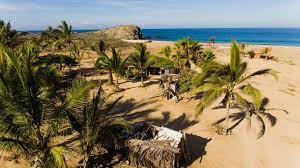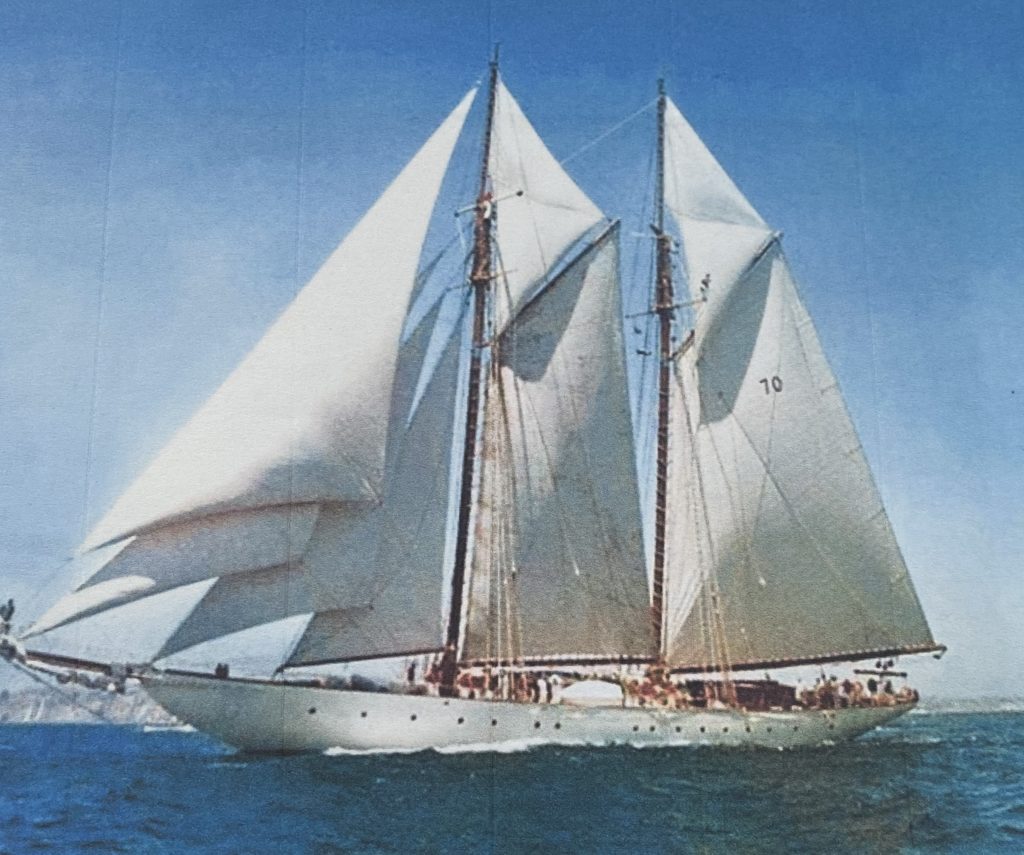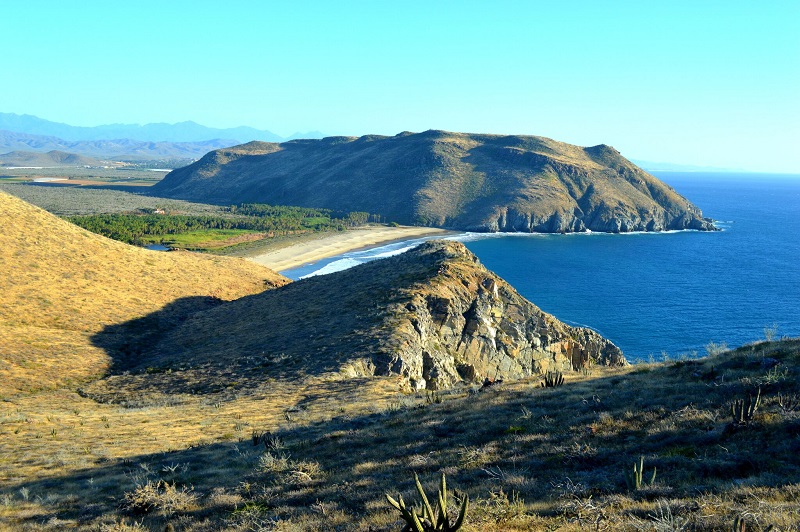
Rancho Gaspareño: The Transformation of Baja California Sur
A tumultuous, exhilarating, infuriating and irrevocable shift of population, outlook, culture and vision is sweeping the lower part of the Baja peninsula. Some residents who have been here for a time are eagerly embracing the evolution, spreading the new concepts one joyous Instagram post after another. Others remain faithful to the old days and ways, testily resisting the transformers one grumpy Todos Santos Newsfeed post after another. Who is really a Todos Santeño? Paraphrasing Colson Whitehead’s beautiful tribute to New York, “No matter how long you have been here, you are a Todos Santeño the first time you say, ”That used to be Café Santa Fe” or ”That used to be Santana’s.” … You are a Todos Santeño when what was there before is more real and solid than what is here now….You start building your own private Todos Santos the first time you lay eyes on it.”
For Greg Schredder the first time he laid eyes on Todos Santos was in 1961 from the sea, but he’d been driving down the Baja peninsula for a couple of years by then. “A bunch of us southern California surfers started coming to Baja in 1959” recalls Greg. “Because there was barely a road and certainly no gas stations at that time, we retrofitted our old truck with a custom-built 55-gallon gas tank and brought what we called our Tijuana credit card, a one-inch tube that we’d use for siphoning the gas we bought at the ranches. The ranchers were always incredibly welcoming and ready to help us with gas and anything else we needed. Of course, we didn’t always find them in time and we were often stranded for days. We didn’t care, we were just always looking for waves.”
The fishermen were equally welcoming. “We would travel with 10-pack cartons of unfiltered, Delegado cigarettes, and one carton would get us up to 50 pounds of lobster. Everything was so abundant then. We’d actually get tired of eating lobster and so we’d use it as bait to go fishing. It was not uncommon to see 600-pound groupers in the Pacific lagoons in those days, and the fishermen would actually catch these giants with their hand lines. We loved staying in the fishing villages on these trips. We would surf, dive, fish, and learn incredible stories of these people living in the most remote locations. You could hear your heartbeat for a quarter mile it was so quiet and still. We would always bring baseballs, gloves and Playboy magazines, and we made friends and had a great time everywhere we went.”

Greg’s introduction to Todos Santos was rooted in much more glamorous transportation than the type that required a Tijuana credit card. “In the 1950s and 60s, most of us surfer kids in Newport, California worked on the yachts of famous people like André Previn, Julie Andrews, and Humphrey Bogart to make money, and they really treated us like family. In 1965 I came to Cabo on Ralph Larrabee’s yacht, Goodwill, and stayed for about a month. At that time Cabo was really just a small village with no electricity. Larrabee’s friends like Donald Douglas (of Douglas Aircraft fame) and John Wayne would fly in to spend a few days partying and fishing, then fly back home. It was during these downtimes that I first explored the Pacific Coast between Cabo and Todos Santos. It was a surfer’s paradise.”
Greg’s friendship with the likes of Douglas and Wayne ended up lasting decades and inspired many of his business ventures across Mexico and Costa Rica. “I would often travel with them over the years, and they are the ones who motivated me to get a real job. As a surfer and diver I decided to set up factories in La Paz and Tijuana to make rubber products related to those activities. We expanded that business into setting up factories for many Fortune 500 companies who needed inexpensive, repetitive labor. We were the largest employer in La Paz and Ensenada for over 20 years. Of course, before the highway came in, it could take up to 2 days to drive to Todos Santos for some surfing.”
“I have always loved the Pacific side of Baja, and in 1979 I bought Rancho Gaspareño, 50 acres of remote land along a quarter mile of the Pacific coastline, not too far from Todos Santos. One of the people who drew me to the area was Carmen Salgado Agramont. She had a little cantina with a hitching post out front for horses where she’d serve up warm beer and hot food. She was quite savvy, and bought the first gas refrigerator in the area. She almost couldn’t keep up with ranchero demand for cold beer after that, and there were always dozens of horses around her cantina. I loved that place, and it was Carmen’s son who set me on the path to buying the ranch, which actually has the name and signature of Benito Juarez on the original land grand title. Since then I’ve been growing coco palms on the ranch, and have also been experimenting with growing plants from Hawaii like breadfruit that have excellent potential in Mexico.”
Greg loves the history of the area. “Rancho Gaspareño was named after a Spanish galleon that went aground on the point, the Gaspareño. It was one of the so-called Manila galleons, Spanish ships that sailed between the Philippines and Acapulco for 250 years, bringing spices, silks and other luxuries from the far east to New Spain. All these galleons sailed the Pacific coast of Baja on their way to Acapulco, so naturally enough the area became riddled with pirates, many of them English and Dutch. There are many tales of buried pirate treasure in the area, and local school groups still come to explore the cave at Rancho Gaspareño each year to tap into the lore. Treasure hunters have reason for optimism; in 1974 when the road from La Paz to the ferry terminal at Pichilingue was being built, a pirate chest of plundered loot was discovered by road workers.”
“I think of this part of the Baja coastline as the forgotten area” continues Greg. “People drive past Rancho Gaspareño going a hundred miles an hour on the new 4-lane highway and have no idea of the history of the area.” The Guaycura and Pericue Indians were the original inhabitants before the Jesuit’s arrival in 1697, and they were essentially wiped out by the time the Jesuits left in 1768. The Jesuits built their theocracy based on a promise to the King of Spain to get rid of the pirates who were plundering his ships, and the pirates faded away with the demise of the Manila galleons in 1815. Dominican Padre Gabriel González had a ranch near Gaspareño from 1825 to 1850, and the tobacco, rum, sugar, corn, and livestock he produced there made him the richest man in Baja California. From his ranch the padre engaged in espionage and guerilla warfare during the Mexican-American war of 1846-1848, and – thanks in part to the Padre – Mexico won a major victory near Gaspareño (but lost the war). By 1855 the Padre had lost his political backing and left Baja for good. For the next one hundred years entrepreneurs made fortunes in the sugar cane industry with fields in areas like Gaspareño, but in the 1950s a severe drought and price drop lead to the demise of the industry; the last sugar processing plant closed in 1974. In that same year the trans peninsular highway made its way to Todos Santos, bringing new life to the town, and in 1985 renowned artist Charles Stewart arrived from Taos, planting the seed for Todos Santos’ current incarnation as an artists’ colony. It remains an agricultural center and surfing hotspot, only now it is firmly on the radar of major developers.
62 years after his first trip down the Baja peninsula, Greg is ready to carve out a little hacienda for himself and his art collection, but let someone else take over the bulk of the land that is Rancho Gaspareño. He has kept his 50 acres wild and free, but would love to see someone with vision and passion create a place of beauty that celebrates the area’s thrilling past, and embraces an artistic, sustainable future. Someone who started building their own private Todos Santos the first time they laid eyes on it.
Of course, letting go of a big piece of the ranch is bittersweet for Greg. Paraphrasing Colson Whitehead’s tribute to New York once more, “We can never make proper goodbyes… Maybe we become Todos Santeños the day we realize that Todos Santos will go on without us. …. Naturally we will cast a wary eye toward those new kids on the block, but let’s be patient and not judge too quickly. We were new here, too, once.” Yes indeed. A tumultuous, exhilarating, infuriating and irrevocable shift of population, outlook, culture and vision is sweeping the lower part of the Baja peninsula. It always has.

